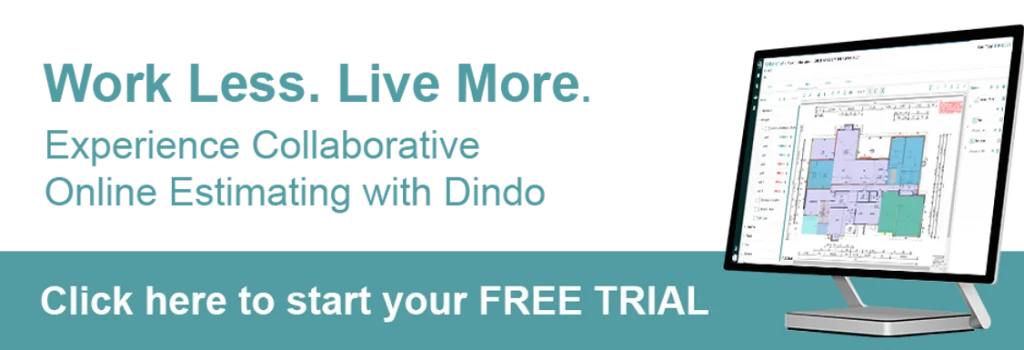My journey into Estimating Software – A retrospective by Trevor Hilaire

I am an old school estimator who, from the start of the metric system in construction (1973) till early 1978 worked for a large project home builder. Of course, that was well before the days of computers but we could go to the Science Museum in Ultimo, Sydney, and see a computer that filled up a whole room and played noughts and crosses. We could sometimes beat it.
After 1978 I became a Quantity Surveyor where everything was of course written by hand on “Dim Sheets” (dimension sheets) and most jobs were stored in boxes containing reams of dim sheets. We never calculated out the dim sheets, that was the role of a comptometrist (comp) who had a special machine very unlike our calculators, it even had a handle to pull when you wanted a total.
In 1986 I was approached by a fellow who had developed a software package that could handle estimating and quantity surveying and even print out the results. This was a bold claim as most computers still ran DOS (the operating system before Windows) on floppy disks, a 10 megabyte hard drive was an unfillable monster, printers were mostly dot matrix and you had a choice of colours for the computer screen of amber or green. My first computer had a massive memory of 128 kilobytes, a green screen, dual floppy disk drives and a switch to change the speed of the processor, it was sold as the “Turbo” version so who wouldn’t want that. In 1986 I believed the silver-tongued devil who made the unbelievable claims and bought my first estimating/quantity surveying software. How did it turn out?
Experiences with software
When I took delivery of the estimating/quantity surveying software it represented a dream I had been sold along with some very high expectations. I was enthusiastic and intended to make a fortune from the time I saved. People in a similar role to me were not so convinced and questioned the advantage of the software given that completing jobs faster would only benefit clients who were charged hourly. I didn’t see the sense in those ideas and pushed on with the software.
My first experience was not quite what I expected, the salesperson had fluently whisked through a demonstration making things look ever so easy. When it came to flying solo it was a different story, it was unfamiliar and daunting. I had selected a simple project to break in the software and I was struggling. On the second day, I remember phoning the help desk and asking how I inserted a line if I forgot an item in a trade. The simple answer from a fellow who was ever so patient and helpful was “press the insert key”. I still cringe at the thought of that call and my inability to find a key that was right in front of me despite an hour or so of searching. My wife and daughters have a term for that and it’s a “man look”. I don’t think I have called a help desk since.
I struggled through my first project with the software. What would have taken me about three days by hand took me over a week of big exhausting days and I thought I had made a bad decision. I was reluctant to carry on but I guess pride or just being stubborn made me take on another project for a test. To my surprise, the second project went much smoother, it still took me longer than it should have but it was better than the first attempt. It was enough to encourage me to endure a third attempt. The third project went smoothly and was completed in about the time I would expect for the old handwritten system. Subsequent projects were completed more and more expediently. Within a couple of weeks, I could not go back and the software was here to stay.
As I continued with the software I found that I was measuring similar dimensions several times in a trade or project and I found I could group these dimensions and copy/paste them whenever they were needed. I found other little tricks as well. I could copy and alter descriptions from other projects where I had written a good one and so efficiency was really boosted beyond anything I could have ever anticipated. The software was definitely worth the investment.

Hindsight shows education is the key
However, what about that steep learning curve? What about those first few weeks of frustration and bewilderment is that the same for everyone? I am happy to say that it is not. In my view the first experiences I had were those of a fiercely independent pioneer who, to this day, is reluctant to ask for help. I had no one at work to show me the way or give a little guidance.
As our business grew I trained a few of our own staff and it is my firm belief that, for someone who knows the basics of construction and estimating it will take about one hour of instruction and tutoring before they become productive with estimating/quantity surveying software. That one hour of instruction would represent the couple of weeks I spent in a fiercely independent pioneer struggle and I think it is worth the time invested if it is possible to get. If you are struggling with coming to grips with your software don’t give up as maybe an hour of tutoring will see you through.
However, what is the case if someone doesn’t have the basics of construction or estimating/ quantity surveying? What if they aren’t proficient at estimating? I worked for the last ten years as a university lecturer showing people with mostly very little experience in construction or estimating how to use software. The best approach I found was to explain the basic aspects of a trade, how to measure those aspects, and then how to build up or compare prices to form an estimate. The 300 – 400 students each semester (12 weeks) would become fairly proficient from what could be considered a standing start. If you are new to construction or estimating then a short course would be well worth your while.
What if someone has their own system developed over a few years of trial and error? In my working life, I have seen many estimating systems that don’t conform to the general ideas of estimating and there is nothing really wrong with that. Some mimic accounts packages and seem ultra inefficient to an outsider. However, these one-off systems can still be accommodated by software and benefit from the advantages. Unfortunately, many of the efficiencies inherent in the general system are surrendered without the user’s knowledge. My suggestion to people with these types of systems would be that they investigate a general estimating short course and then meld the best examples and efficiencies from general estimating principles into their own system thus gaining the best of both worlds.
Whatever way you look at it, education is the key. Whether it be one hour or a short course there will be advantages that will reduce your stress, introduce you to new ideas and bring you up to speed more expediently.


